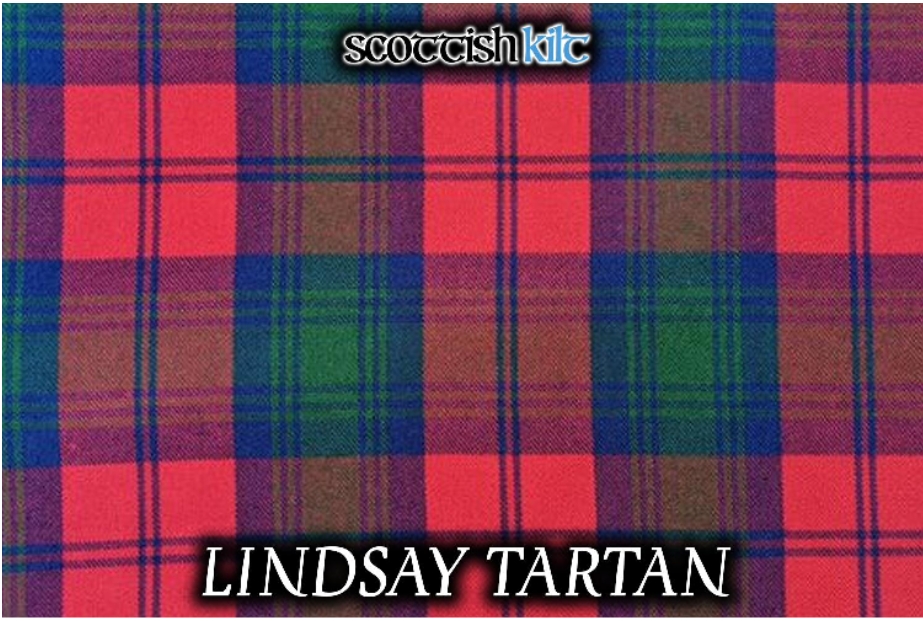Lindsay tartan, a timeless emblem of Scottish heritage, captivates with its distinctive design and rich historical significance. Renowned for its vibrant colors and intricate patterns, this tartan embodies the essence of Scottish tradition while seamlessly integrating into modern fashion. Originating from the influential Lindsay clan, the tartan’s enduring appeal is a testament to its deep cultural roots and adaptability. As we explore why Lindsay tartan stands out in Scottish fashion, we uncover not only its historical context but also its contemporary relevance, showcasing how this classic pattern continues to influence and inspire today’s style landscape.
Historical Roots of Lindsay Tartan
The Lindsay tartan is deeply embedded in Scottish history, closely linked to the Lindsay clan, which has been an integral part of Scotland’s heritage for centuries. The Lindsay family, originating from the Scottish Lowlands, was influential in the country’s medieval history. The earliest records of the Lindsay clan date back to the 12th century, with the family holding significant lands and titles, including the Earldom of Crawford. The clan’s prominence extended into various spheres, from military leadership to political influence. The Lindsay tartan reflects this illustrious background, symbolizing the clan’s status and contributions. Historically, tartans were more than just patterns; they were a way to signify clan identity and allegiance. The Lindsay tartan’s design thus encapsulates a legacy of power and prestige. In the 18th and 19th centuries, the interest in tartans surged, partly due to the efforts of figures like Sir Walter Scott and the romanticized portrayal of Scotland’s past. During this period, tartans, including the Lindsay, became symbols of Scottish nationalism and identity. The Lindsay tartan, therefore, carries not only the heritage of the Lindsay clan but also the broader cultural revival of Scotland.
Distinctive Design Features
The Lindsay tartan is immediately recognizable due to its distinctive pattern and color scheme. Typically, it features a combination of deep greens, rich blues, and bold reds, which are arranged in a symmetric checkered pattern. This arrangement is not merely decorative but follows traditional Scottish weaving techniques that have been perfected over generations. The green in the Lindsay tartan often represents the lush Scottish landscapes, symbolizing the natural beauty of the country. The blue hues are reminiscent of the vast Scottish skies and lochs, while the red adds a touch of vibrancy and energy. The interplay of these colors creates a balanced and harmonious design that stands out in any setting. The tartan’s pattern is characterized by its evenly spaced lines and checks, which are meticulously woven to ensure consistency and quality. This precise design requires skilled craftsmanship, and the tartan’s enduring popularity is a testament to the excellence of traditional Scottish weaving techniques. The attention to detail in the tartan’s design not only enhances its aesthetic appeal but also reflects the rich heritage of Scottish textile arts.
The Symbolism Behind the Colors
Each color in the Lindsay tartan carries a layer of symbolism, contributing to its overall significance. The primary green shades are often associated with Scotland’s verdant landscapes, reflecting the country’s lush natural environment. Green is also a color of renewal and vitality, suggesting a connection to the land and its cycles. The blue in the tartan symbolizes the serene and expansive Scottish skies. It evokes a sense of tranquility and depth, mirroring the country’s vast horizons and the calm of its numerous lochs and rivers. Blue also carries connotations of loyalty and fidelity, adding a dimension of trustworthiness to the tartan’s symbolism. Red, a prominent color in the Lindsay tartan, is often linked to courage and strength. It represents the passion and energy that are integral to Scottish spirit and heritage. The bold use of red in the tartan not only makes it visually striking but also emphasizes the dynamic and resilient nature of the Scottish people. Together, these colors weave a narrative that celebrates Scotland’s natural beauty, cultural depth, and historical significance. The Lindsay tartan’s color palette thus serves as a vivid representation of Scottish identity and values.
Modern Adaptations and Trends
In recent years, the Lindsay tartan has experienced a revival in modern Scottish fashion. Designers and fashion houses have embraced traditional tartans, including Lindsay, and incorporated them into contemporary apparel. This trend reflects a growing interest in blending historical elements with modern style. The adaptability of Lindsay tartan makes it suitable for various fashion items, from traditional kilts to casual wear. Designers have experimented with the tartan in different fabrics and cuts, creating new and innovative pieces that appeal to contemporary tastes. This versatility ensures that the Lindsay tartan remains relevant in today’s fashion landscape. The resurgence of tartans in fashion can also be attributed to a broader cultural movement that celebrates heritage and authenticity. By integrating traditional elements into modern designs, fashion designers honor Scotland’s rich history while making it accessible to a new generation. The Lindsay tartan’s timeless appeal, combined with modern styling, highlights its continued importance in Scottish fashion.
Popular Uses in Contemporary Fashion
Lindsay tartan has found its place in a wide range of fashion items, reflecting its versatility and enduring appeal. One of the most popular uses is in traditional kilts, where the tartan’s colors and pattern are prominently displayed. Kilts made from Lindsay tartan are often chosen for formal occasions, including weddings and ceremonial events, where the tartan’s historical significance adds a touch of authenticity and tradition. Beyond kilts, Lindsay tartan is also featured in accessories such as scarves, ties, and bags. These items offer a way to incorporate the tartan’s distinctive pattern into everyday wear. The use of tartan in accessories allows individuals to express their Scottish heritage in a subtle yet stylish manner. In addition to these traditional uses, Lindsay tartan has been adapted for casual and contemporary clothing. Designers have created modern garments such as jackets, trousers, and skirts that incorporate the tartan’s pattern. This innovation ensures that the Lindsay tartan remains a relevant and fashionable choice for a wide range of occasions.
Celebrity Endorsements and Media Influence
Celebrity endorsements have played a significant role in elevating the status of Lindsay tartan in contemporary fashion. High-profile individuals wearing the tartan have brought it into the spotlight, showcasing its versatility and appeal. These endorsements often appear in fashion magazines, social media, and public appearances, contributing to the tartan’s popularity. The media’s portrayal of Lindsay tartan has also influenced its perception. Fashion shows, television programs, and films set in Scotland or featuring Scottish themes often highlight traditional tartans, including Lindsay. This exposure helps maintain the tartan’s relevance and introduces it to a broader audience. The influence of celebrities and media extends beyond fashion, impacting cultural perceptions of Scottish heritage. By associating Lindsay tartan with modern style and high-profile individuals, the media reinforces its status as a symbol of both tradition and contemporary elegance.
The Tartan’s Role in Scottish Heritage Events
Lindsay tartan is a prominent feature in various Scottish heritage events, where it plays a role in celebrating Scotland’s rich cultural traditions. Events such as the Highland Games, Burns Night, and the Royal Edinburgh Military Tattoo often showcase tartans, including Lindsay, as part of their ceremonial attire. At these events, the tartan’s presence underscores its historical and cultural significance. Wearing Lindsay tartan at such gatherings not only honors the heritage of the Lindsay clan but also contributes to the broader celebration of Scottish identity. The tartan’s use in these contexts highlights its importance in preserving and promoting Scottish traditions. Additionally, the tartan’s role in heritage events reflects its versatility. Whether worn as part of traditional dress or incorporated into modern outfits, Lindsay tartan remains a symbol of Scottish pride and cultural continuity. Its continued use in these events ensures that it remains an integral part of Scotland’s cultural landscape.
Craftsmanship and Quality
The craftsmanship behind Lindsay tartan reflects centuries of tradition and expertise in Scottish weaving. The tartan is woven using high-quality wool, which is carefully dyed and spun to achieve the desired colors and patterns. The weaving process requires skill and precision, ensuring that the tartan maintains its integrity and visual appeal. Scottish tartan weavers have honed their craft over generations, passing down techniques that have been perfected over time. The use of traditional weaving methods contributes to the tartan’s durability and comfort. Each piece of Lindsay tartan is a testament to the craftsmanship that has been valued and preserved in Scottish textile arts. The attention to detail in the production of Lindsay tartan highlights its importance as a symbol of Scottish heritage. The quality of the tartan not only enhances its visual appeal but also ensures that it remains a lasting and cherished item. The craftsmanship involved in creating Lindsay tartan reflects the dedication and expertise of Scottish artisans.

A Blend of Tradition and Modernity
Scottish Clothing encompasses a rich array of traditional garments and accessories that reflect Scotland’s vibrant cultural heritage. From the iconic kilt, often adorned with family-specific tartans, to intricately designed sporrans and meticulously crafted jackets, Scottish clothing is a celebration of history and craftsmanship. This attire not only serves as a nod to Scotland’s past but also finds relevance in contemporary fashion, with modern adaptations bringing traditional elements into everyday wear. The enduring appeal of Scottish clothing lies in its ability to merge historical significance with current trends, making it a cherished aspect of Scotland’s identity both locally and globally.
Choosing Lindsay Tartan for Special Occasions
Lindsay tartan is a popular choice for special occasions, where its distinctive design and historical significance add a touch of elegance and tradition. For weddings, the tartan is often chosen for kilts, skirts, and other formal attire, allowing individuals to celebrate their Scottish heritage on their special day. The tartan’s versatility also makes it suitable for other formal events, such as galas and ceremonies. Its rich colors and classic design lend a sense of sophistication and refinement, making it an ideal choice for those looking to make a statement. The use of Lindsay tartan in these settings reflects both personal style and cultural pride. Additionally, Lindsay tartan is often incorporated into festive and celebratory attire. Its vibrant pattern and historical connections make it a fitting choice for events such as Burns Night and Hogmanay, where tradition and festivity are central. Choosing Lindsay tartan for these occasions ensures that individuals can embrace their Scottish heritage while enjoying the festivities.
Preserving the Legacy of Lindsay Tartan
Preserving the legacy of Lindsay tartan involves both appreciating its historical roots and embracing its modern applications. By continuing to wear and celebrate the tartan, individuals contribute to the ongoing relevance of Scottish heritage. This appreciation helps ensure that the tartan remains a cherished part of Scotland’s cultural identity. The legacy of Lindsay tartan is also preserved through the efforts of designers and artisans who incorporate it into contemporary fashion. By blending traditional elements with modern style, these individuals help keep the tartan relevant and accessible to new generations. This fusion of past and present highlights the tartan’s enduring appeal and importance. Furthermore, preserving the legacy of Lindsay tartan involves educating others about its history and significance. By sharing knowledge about the tartan’s origins, design, and symbolism, individuals can foster a deeper appreciation for Scottish heritage. This awareness helps maintain the tartan’s prominence and ensures that it continues to be celebrated as a symbol of Scottish pride.
Conclusion
In conclusion, Lindsay tartan stands out in Scottish fashion due to its rich history, distinctive design, and modern adaptability. Its historical roots, symbolic colors, and versatility in contemporary fashion all contribute to its enduring appeal. By embracing and celebrating Lindsay tartan, individuals honor Scotland’s cultural heritage and ensure that this iconic pattern remains a vibrant part of Scottish identity.

Jennifer David is the creative force behind CelebRiches, your go-to source for celebrity financial exploits. With an unwavering passion for the entertainment industry, she delivers in-depth insights into celebrities’ net worth, combining thorough research with a captivating narrative. Explore the stars’ fiscal journeys through Jennifer’s expert lens, where finance meets fame most engagingly.
